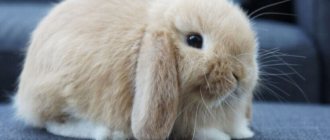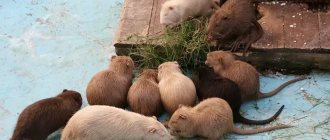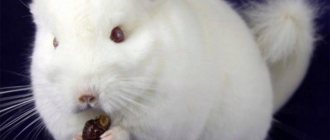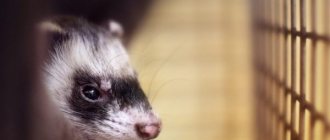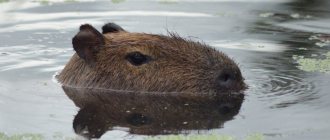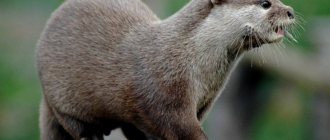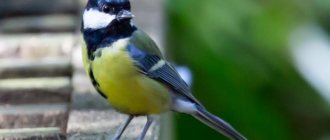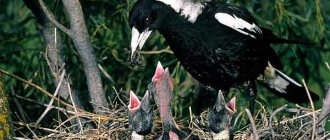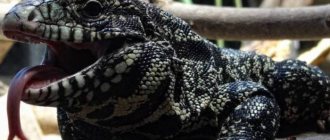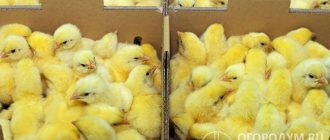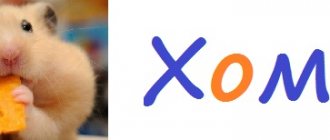Description of the species
Nutria are much larger than rats, but smaller than beavers. They grow in weight from 5 to 12 kg, some individuals are even larger in size. The average length is 60 cm. The body is disproportionately developed compared to the head and limbs.
This is an amphibian animal; for comfortable living, it equally needs water and land. The water preferences of these mammals are indicated by the membranes between the toes on the hind limbs, which makes them resemble crow's feet.
The forelimbs are very small and resemble small human hands. They use them to deftly manage food and clean their own and their children’s beautiful fur coats.
Watching these creatures is very interesting, especially for kids.
Hair also helps animals feel good in the water. Wool has water-repellent properties: the thick undercoat does not allow moisture to reach the skin, and droplets of water roll off the long, coarse hairs. So nutria literally get away with it. All they have to do is shake themselves and not a drop will remain on them.
And another decoration of nutrias, one might say, their pride, is their long front incisors of a gorgeous orange color. No one else has these and it is easy to recognize representatives of the breed by them.
Nutria with different coat colors are bred under artificial conditions: black, fawn, brown, gray, white, beige, pink, golden, etc.
Range, habitats
The marsh beaver is found in southern South America (from southern Brazil and Paraguay to the Strait of Magellan) . The spread of nutria to other continents is associated with targeted efforts, which, however, are not always successful. In Africa, for example, the rodent did not take root, but it became familiar in North America and Europe.
Nutria (676 from Argentina and 1980 from Germany/England) were brought to the Soviet Union in 1930-1932. In Kyrgyzstan, the regions of Transcaucasia and Tajikistan, the introduction was successful. The range of the coipu may be “shrinking” due to harsh winters. Thus, severe frosts in 1980 completely destroyed rodents in the northern states of the USA and Scandinavia.
Nutria prefers to settle near bodies of water with stagnant/weakly flowing water: on swampy coasts, lakes covered with cattails and alder-sedge swamps, where there are a lot of plants. However, the animal does not like dense forests and does not rush to the mountains, so it is not found above 1200 m above sea level.
Return to content
Some content features
Experienced nutria growers share their experience of growing nutria at home:
- Sow - features and characteristics of selection and rules for keeping a sow (photo + video)
Domestic pig - features of keeping and breeding pigs, recommendations for feeding and care
- Sheep clipper - the main tool for harvesting wool, selection rules and characteristics of the tool
You need to be prepared for the fact that nutria are not averse to chewing on the wooden parts of the enclosure. The cages may need to be repaired from time to time. Animals can dig under or damage fences and get out.
Sooner or later the animals will need to be caught. For example, to place them in a separate cage for mating or breeding, or you will have to return the fugitives to their place.
To prevent the animals from biting their owner, which they do is quite painful, they are caught by the tail and carried by weight. It will not cause them pain, and they will not be able to cause harm.
If you want to pamper your pets, pick marsh grass - sweet sedge or reed. This will be a true gastronomic delight for the nutria.
Disease Prevention
Unlike rabbits and other fur-bearing animals actively bred in Russia, nutria are surprisingly resistant to most common infectious diseases in our country. Of course, it is important how correctly the nutria are cared for and bred, as well as the genetic purity of the population, but in general the level of nutria health amazes experienced rabbit breeders.
To prevent diseases you need:
- Maintain maximum cleanliness in enclosures and cages - regularly remove manure, change water daily.
- Twice a year, for example, in spring and autumn, it is recommended to completely treat the farm and all equipment with special solutions (lysoline, creolin or formaldehyde).
- Also, do not neglect the mats placed in front of the entrance to the nursery, soaked in a disinfectant solution.
- The appearance of rats and mice on the farm should be prevented in every possible way.
- Place garbage and manure pits as far as possible from the enclosures.
- Before introducing new animals (purchased from another farm or nursery), their home must be disinfected, and the animals themselves must be quarantined for a month.
As for non-infectious diseases, nutria most often suffer from frostbite and food poisoning. However, in the vast majority of cases, such incidents are the fault of the farmers themselves.
Dangers
Nutria are characterized by good health. All that can harm them is improper, disordered nutrition.
The harsh climate is also not to the liking of the animals. They are afraid of drafts and severe frosts. A warm fur coat reliably protects their body from any cold weather. But the tails and paws are covered only with skin and are easily susceptible to frostbite. The wounds heal poorly and the animals suffer greatly.
As in any living community, it is possible that aggressive individuals will appear that will attack and injure relatives and humans. Their behavior is not corrected. Such animals should be identified, isolated and disposed of first.
What to do immediately after childbirth
She can handle all the work on her own, lick the cubs and handle the litter. Your job is simply to lay down clean bedding. Milk from newly born nutria is nutritious and appears almost immediately after birth. Babies dry quickly (as a result, it is important that the room is warm and comfortable), approach the nipples and suck on them constantly. After giving birth, the female may behave differently. It can even throw babies and rush around the cage. At such a moment, she needs to be placed with the male for a couple of hours, and then returned to the children.
Advantages
Why is it possible to master keeping nutria at home even for beginners in running a family business?
Unpretentiousness to environmental conditions.
Availability and low cost of feed.
Resistance to infectious viral diseases is much higher than that of rabbits, chickens, and pigs.
They reproduce quickly and easily. Cubs are born sighted, able to walk and swim. The offspring do not need additional care. It is enough to provide mothers and babies with separate housing and maximum peace.
Cleanliness. Animals do not stockpile food, which can spoil. They eat by carefully bringing food to their mouth with their front paws. Every day they bathe and thoroughly clean the skin after water procedures. Most even set up a toilet in one specific place.
Nutria are not aggressive, they get used to humans, allow themselves to be stroked and cleaned in the cage.
Commercial value consists of fur, which has high wear properties and dietary meat; its nutritional properties are not inferior to rabbit meat - low-fat, easily digestible.
The sale of young animals can also provide a stable income.
Sufficient breeding experience in Russia and the USSR with low competition.
High profitability of nutria farming.
Animal Reproduction
Nutria reproduce throughout the year, males are constantly active, and in females the period of sexual desire is on average 25 days.
- A litter usually contains up to 6 puppies, but can reach 10.
- Pregnancy lasts about 127 days. The female gives birth to two or three litters per year. Feeds puppies up to one and a half months of age.
- They are ready for mating at six months, but experienced nutria breeders postpone this process until eight months.
- This gives an absolute guarantee of getting a healthy offspring without injuries and rickets.
- During pregnancy, the female must be protected from fright and loud noises and visit her cage only during feeding. They often have miscarriages.
One male easily covers several females. They check the favorable outcome of mating by feeling the girl’s abdomen - if small balls are felt under the fingers, then the process was successful.
The nutria pet does not create much trouble in keeping, is not prone to infectious diseases, is resistant to colds, easily tolerates cold due to its fur, and is unpretentious in nutrition. Therefore, the popularity of this type of livestock farming is growing.
Slaughter of nutria
Animals are bred for their skins and meat. Therefore, you need to slaughter nutria, trying to cause as little damage as possible and not spoil the fur.
If you have experience in slaughtering rabbits, then you will not have any difficulties with how to slaughter nutria at home. For those who will be doing this for the first time, it is possible to involve an experienced nutrivodist, watch a video on the Internet, or use our recommendations.
There are two approaches to killing animals: manual and electric.
Manual method
When slaughtering by hand, you need to try to irritate the animal as little as possible. Prepare a place with dim lighting in advance. This should be done when the animal is less active.
The animal does not need to be fed for at least half a day so that its stomach is empty.
For slaughter, prepare a stick with a thick end, which you wrap tightly with cloth so as not to pierce the skull and not to splatter the fur with blood.
Next, the animal is taken by the tail closer to the body and killed with a well-aimed strong blow to the head. It is very important to do this the first time and not stun the animal. Otherwise, the meat is considered unfit for food.
After the animal has died, they begin skinning the carcass.
Electric way
It is considered more humane and reliable than manual. The animal dies under the influence of an electric current of 220 Volts for three seconds.
A current is passed through the front and back legs of the nutria. Typically, insulated clothespins are attached to exposed wires.
You need to work in rubber gloves and non-conductive shoes and follow safety rules when contacting electrical appliances.
Caring for young animals
Young with mother
Young nutria have fur, teeth, they see, walk, and swim. The first few days there is a danger of hypothermia. Then they adapt. Cases of healthy cubs killing weak ones are quite rare. If this happens, the diet should be changed, making it more nutritious by adding more protein feed, as well as minerals and vitamins. Especially vitamin A. It is possible or even necessary to transfer the cubs to another young animal on the first day, since “stepmothers” often abandon babies that smell like another female. At this time, you can let the nutria out for a walk so that it stays there for about half an hour. This time is enough for the planted cubs to acquire the smell of a new home. During the first four to five days, newborns need to be monitored more often. If the amount of milk is sufficient, then they move briskly; in the summer, they swim and willingly eat food. If newborns are inactive and their fur becomes unkempt, the female’s milk production should be monitored. This is done simply. The animal is caught by the tail, turns over on its back, holds its paws, and with light pressure the milk is squeezed out of the nipple. It is likely that there is not enough of it - as a result, nutrition needs to be improved. If there is enough milk, then it is possible that something is wrong with the conditions of detention. There may be drafts or it is very hot. Also make sure there is plenty of water - this is very important. If the female is kept in a cage with a pool, a descent must be equipped for the cubs. After bathing, babies get wet, become heavy and are unable to get out on their own; it is quite possible that they may drown.
Skinning
There is a technology that must be followed when tanning nutria skins at home. Then you are guaranteed to receive high-quality fur, preserve its characteristics, the strength of the skin and, accordingly, you will be able to get good money for it.
It is very important to kill the animal correctly and drain the blood so as not to damage the hair or damage the integrity of the skin.
Skinning should begin immediately after bleeding. It may not be possible to make the cuts correctly the first time to remove the skin with one stocking. With time, experience will come.
The process is described in detail in various sources; if you do not disturb it, then you can begin the actual dressing of the skin.
To do this, excess fat (mesh) is removed from it, then soaked for 12 hours in water with the addition of salt and formaldehyde.
Remove the flesh again with a not too sharp knife by scraping it more thoroughly, but so as not to tear the skin.
Now the skins need to be further degreased in a soap solution. To do this, use regular washing powder. After an hour of such soaking and stirring, the skins are rinsed several times with warm water and allowed to drain.
Finally, they are soaked in a tannin solution. The composition may be different, but it is based on mineral acids. Each furrier has his own recipes, timing and secrets of dressing skins and carefully stores them.
So it’s worth trying several options and choosing your own, the most optimal composition in your opinion. It is unlikely that you will be able to obtain a universal recipe right away.
Drying of the skins after final dressing is carried out on special spacers (rules) or spread with nails on a flat wooden surface.
After final drying, a crusher may be required. It is often replaced by the usual long and thorough kneading with hands.
Dressing hides at home is a long, painstaking and labor-intensive process. But having mastered the technology, you can put the process on stream, especially if other family members are involved.
In this way, you can ensure a stable income, ecologically healthy meat on the table and the pleasure of breeding interesting unusual animals - nutria.
Nutrition
Nutrition plays an important role in the maintenance of nutria. With an incorrect or poor diet, animals become restless, chew their tails, and their fur takes on an unkempt, dull appearance. The animal's summer menu should include:
- fresh grass (clover, alfalfa, reeds) - 1 kg;
- compound feed - 150 g;
- a small amount of chalk, fishmeal, salt;
- seaweed.
In winter, instead of fresh grass, pets are fed hay and supplemented with fresh fruits and root vegetables. The animals are fed twice a day, with the first portion being 40% of the daily requirement, and the evening portion 60%.
When feeding, different foods are mixed and given as a complex. This is due to the fact that when given a choice, rodents become capricious, choosing only the tasty morsels.
Breeding nutria is a profitable business, the popularity of which is due to the unpretentiousness of the animals, simple maintenance and care of the animals. To obtain products, you should know the lifestyle and preferences of nutria in order to provide your pets with the right conditions and avoid illness or
